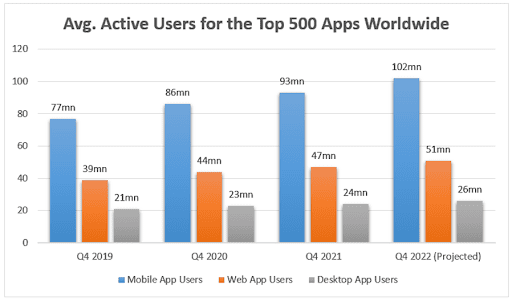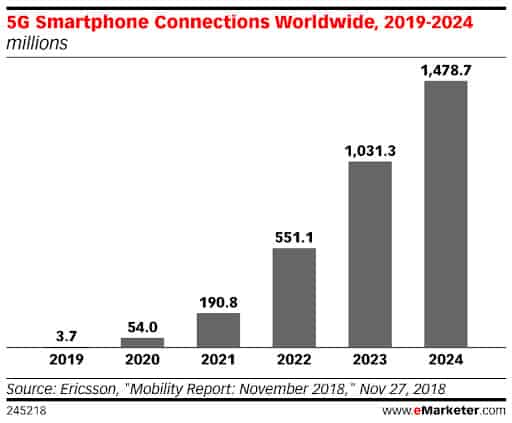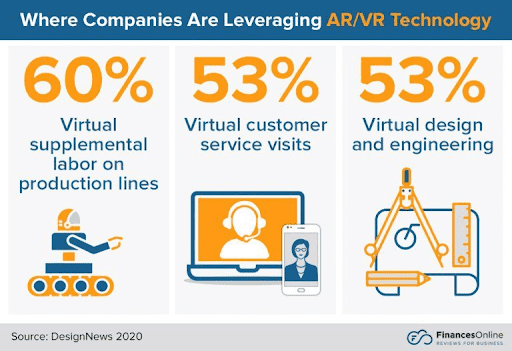
Mobile applications aren’t anymore a luxury or simply a channel to tout your business. More than 70% of our digital media time is consumed by smartphones today. Mobile apps claim 93% of the total time spent on a smartphone, while the remaining 7% of mobile time is consumed by web browsers. This proves why the demand for mobile application development services is intensifying year over year.
A well-structured native iOS, native Android, hybrid, or cross-platform mobile app boosts your digital engagement, leading to long-term bottom lines such as unswerving customer loyalty and recurring sales. Though an astounding number of small and large businesses are experiencing the benefit of mobility, some are yet to build the right strategy. If you are planning to build a mobile app for your business or want to enhance your existing application, you’ve come to the right place.
This blog covers the key aspects of mobile app development, including the development process, approaches, platforms, cost of development, and the tips to avoid failures and attain success with mobile app development. Let’s get started without further ado.

Mobile application development is the process of creating specific software applications that run on a mobile device (such as applications for smartphones and digital assistants), and utilize a network connection to work with remote computing resources. The development process involves creating installable software bundles, implementing backend services, and testing the application on target devices. In short, mobile app development is the strategic process of designing, building, and launching a mobile app successfully.
The importance of building a business mobile app is growing rapidly as businesses across industries aim to meet user expectations and seek real-time, convenient ways to conduct transactions and access information. By the end of 2023, it is estimated that the total number of mobile app downloads will amount to 299 billion, worldwide.

A well-structured mobile app helps you leverage all the benefits offered by the mobile device and the OS for which it is developed. The development process takes into account the limitations of mobile devices and allows you to balance cost with functionality.
Mobile application development platforms bring together all the tools you would require to build your app from start to finish under a single umbrella, as a unified software offering. A mobile development platform saves your developer from juggling different software to complete various tasks involved in the development lifecycle. This prevents data loss and eliminates the risks caused by the wrong classification of data. Using a single software package to carry out the development process – from planning to UI/UX design and testing – saves your cost and time.
Mobile application development platforms differ according to the operating system (OS) they cater to. Here is a list of the top mobile app development platforms:
Sponsored by Google, the Android mobile OS is designed primarily for touchscreen mobile devices such as smartphones and tablets. As of July 2022, Android holds 44.46% of the mobile OS market share in the United States. The biggest advantage of Android OS is that its source code can be downloaded, customized, and distributed by anyone at no cost. The Android OS supports running multiple apps simultaneously on a single mobile device and offers immense flexibility to customize the UI during development to get the desired outcomes.
Unlike the Android OS that can run on numerous hardware brands, the iOS operating system is a proprietary software that runs only on Apple’s devices, such as iPhone or iPad. Developers can leverage the iOS Software Development Kit (SDK) to create mobile apps for Apple devices and distribute the apps through the App Store maintained by Apple Inc. As of July 2022, Apple’s iOS holds 55.22% of the mobile OS market share in the United States.
As the name suggests, a hybrid mobile application blends both native and web programming capabilities within a single application. It allows developers to build applications for multiple operating systems on a single platform. A hybrid application is written using the web technologies – HTML, CSS, and JavaScript – and then the code is embedded into a native application wrapper, which gives it the power of a true native application that can work efficiently on any native platform. Hybrid mobile development platforms are used by organizations that wish to reach a large audience base within a short time, so they don’t have to build two or more separate but similar applications for each OS type.
Native mobile apps are platform-specific applications developed using the programming languages, SDKs, tools, and frameworks provided by the platform itself. These apps are designed to run natively on the operating system (OS) of the device such as iOS or Android. As they are built to work on a specific OS or platform, native mobile apps are faster, more reliable, and offer offline capabilities.
Hybrid mobile applications are built using standard web technologies such as JavaScript, CSS or HTML5. These apps combine the elements of both native as well as web applications. Some of the world’s leading apps such as Gmail, Twitter, Amazon, etc. are examples of hybrid apps. Developers can leverage plugins and APIs to integrate web technology with native app features. Hybrid mobile apps are faster to develop and easier to maintain.
Read more: Choosing hybrid mobile appA cross-platform mobile application works across platforms using a single code base which makes it compatible to run on different operating systems like Android, iOS, and Windows. A cross-platform app can be written using different programming languages and frameworks, but it’s compiled to run like a true native application running directly on the device’s OS. It’s easy to build and maintain cross-platform apps.
Progressive Web Applications (PWAs) present an alternative approach to traditional mobile app development by avoiding the need for app store delivery and installations. PWAs are cheaper, more secure, faster, and easier to develop. They operate via a browser, but act like native apps. PWAs provide users an “app-like” experience by leveraging a set of browser capabilities such as performing a background process, adding a link to the device home screen, and working offline.
Each mobile application development approach has its own advantages and disadvantages. So, choose a method that matches your business purposes and strategy. Right choice helps you achieve the desired user experience and build the native features needed for your application.
Mobile app development technology refers to the various tools, frameworks, programming languages, components, libraries, and other technologies used to create applications that work on smartphones and portable connected mobile devices. Let it be native Android or native iOS, or a cross-platform app, you need to familiarize yourself with the leading technologies and frameworks that power your app.
Here are some of the top mobile app development technologies that dominate the market in 2022:React Native offers a best-in-class JavaScript library for building native user interfaces for your iOS and Android apps, using a single code base that can be shared across all platforms. It allows developers to iterate at lightning speed and create truly native apps without compromising your user experiences.
This software is distributed freely to the users on a trial basis, usually with a limited-time offer. After that, the users are expected to pay if they want to continue to use this application software. Some examples of shareware are WinZip, SnapTouch, and Adobe Acrobat.
Xamarin is an open-source mobile app platform for the .NET which offers tools and libraries specifically for building apps for Android, iOS, tvOS, watchOS, macOS, and Windows.
If you are building something specific to Apple OS (native to Apple), Swift is the language to seek. Swift is a popular iOS application development language that offers advanced features with minimal coding that can be easily maintained. Swift is a powerful and intuitive language loved by Apple developers who use it for macOS, iOS, watchOS, tvOS, and so on.
Ionic is a modern, open-source mobile development framework that offers seamless app UX across iOS, Android, and the Web from a single shared codebase. Ionic is built on top of Angular JS and Apache Cordova. Ionic is the easiest way for web developers to build, grow, and scale cross-platform mobile apps.
Apache CordovaApache Cordova is a free and open-source mobile development framework that leverages HTML, CSS, and JS to target multiple platforms with one code base. The framework is an ideal choice if you want to extend your application across more than one platform, without having to re-implement it with each platform's language and tool set.
Sencha Ext JSSencha Ext JS is a highly comprehensive JS framework for building data-intensive, cross-platform web and mobile applications for any modern device. It offers numerous enterprise-ready tools, components, and libraries to create stunning mobile and web applications.
The list of mobile app development frameworks and tools is expanding day by day. To choose the right development technology for your mobile app, you need to consider factors such as platform feature support, speed considerations, cost of development, security risk, efficiency of the app, and after launch updates.
With all the facts and trends substantiating the significance of business mobile apps in 2022, it is important to look at the mobile application development process step-by-step.
Here is an overview of the mobile app development lifecycle: 1 Researching 2 Wireframing 3 Assessing Technical Feasibility 4 Prototyping 5 Designing 6 Developing 8 Launching 1 ResearchingEvery app begins with an idea. However, your app can be successful only when the idea benefits your customers (app users). Ensure that your analysis includes the demographics, motivations, and behavior patterns of your buyers.
2 WireframingDrawing a detailed sketch of the envisioned product helps you uncover the usability issues of your app. After sketching, wireframing helps refine your idea and organize all the essential components.
3 Assessing Technical FeasibilityAsking questions, brainstorming ideas, and reviewing the status allow your team to decide the initial functionality’s feasibility.
4 PrototypingCreating working prototypes or mockups of your application allows you to verify if your development process is moving in the right direction. Prototyping enables different stakeholders to have a first look at your app and validate the information you have gathered.
5 DesigningCreate multiple variations of the screen. A clear visual direction helps you visualize the final product.
6 DevelopingThis is the core phase of the application development process, where you actually develop the mobile app.
The app is delivered to the potential users to test its user experience. Their feedback and opinions will help you add what your app lacks from their point of view.
8 LaunchingPublish your app to the app store. Plan regular app maintenance to fix bugs and enhance user experience.
The mobile front-end (client-side rendering) is the visual and interactive part of the mobile application that a user interacts with, while the back-end (server-side rendering) stores, secures, and processes the data.
Some of the key front-end jobs include web designing, UI designing, UX designing, and front-end development. Back-end developers create the services to process the business logic and access the database, cloud services, and file servers to render the app on the server-side.
For applications where there is no interaction with a server, front-end and back-end developer roles can be performed by one person. For applications that require internet connection and interaction with a server, you need to hire separate developers for developing each component.

To stay on top of competition in the mobile application market, you must test your application before starting the actual sprint. Here are nine steps to ensure the success of your mobile application:
These steps of mobile application testing ensure efficient performance of the entire software system.
Have you selected the right mobile app development approach? If not yet, download our white paper to learn more about native, hybrid, cross-platform, and progressive apps.
5G will transform the way mobile applications are created and used. By the end of 2022, it is estimated that the total number of 5G smartphone connections will be three times more than that in 2021.
5G will drastically improve the speed and efficiency of mobile apps, allowing developers to add new features without risking the app’s performance. 5G is expected to boost network efficiency and traffic capacity, with an estimated 10x decrease in latency.

Like AR, VR is also transforming mobile app development today. For example, VR can connect with phones, apps, and wearables to enhance the user experience and content perception of fully functional mobile apps. According to Design News, 29% of manufacturers reported an increase in their productivity and efficiency since they implemented AR/VR technology into their organization.

The increasing shift of web and mobile apps to containerization and microservices is popularizing the adoption of low-code apps today. Over 75% of the apps developed in 2021 were built using low-code platforms for reducing the time to market and addressing the shortage of skilled developers. Low-code mobile development allows businesses to quickly roll out their apps, reduce complexity in development, swiftly adapt to market changes, reduce hiring costs, and maintain a consistent user experience.
The increased reliance on digital devices, particularly smartphones and tablets, has made mobile the most preferred channel for online shopping in recent years.
Simply put, mcommerce refers to shopping through a mobile device, typically using a smartphone. Thanks to the coronavirus pandemic, the retail industry has undergone potentially the greatest digital transformation, which has pushed the online selling of almost everything we buy from physical retail stores. Millennials and Gen Zers own a massive spending power to shop widely on their smartphones. Customers seek seamless buying experiences without leaving the platform they use. Nor do they like to re-enter payment details each time they try to shop via your mobile app. Adding “Buy Now” buttons to your social media pages and introducing “one-click checkout” to your mcommerce app could turn into a major customer acquisition advantage.
Predictive analytics is a ground-breaking trend in mobile app development that leverages technologies such as machine learning, AI, data mining, and data modeling to predict events using data. Netflix, for example, uses predictive analytics to recommend users TV shows and movies based on what they have watched previously.
Based on your data, predictive analytics can estimate the duration of your mobile app’s development cycle, the amount of testing required to launch your MVP (Minimum Viable Product), or the expected bugs or errors on your testing pipeline. All these expedite your mobile app development, ensure the quality of your app before delivery, minimize the development risk, and increase your ROI.
Read more: Trends Impacting Mobile Application DevelopmentHaving a general understanding of how your targeted market keeps shifting based on these trends will help you adapt your mobile application swiftly.
Custom mobile apps are tailor-made applications created to address the requirements of a specific audience rather than a massive group of people. Custom mobile app development provides the functionality and features that plain off-the-shelf solutions cannot. Compared to pre-packaged, canned solutions, customized applications offer the following benefits:
Improved Data Security Seamless Integration with Other Software Highlight Your Competitive Advantage High Scalability Long-term Support and Maintenance Improved Data SecurityCustom mobile apps offer robust data protection against cyber-attacks by using additional configurations and measures, which off-the-shelf apps don’t provide. When you have a custom-built mobile app, your confidential data will not be available publicly. A unique security code and encryption are used to hack-proof your mobile application from any such attacks.
Seamless Integration with Other SoftwareMost commercial, off-the-shelf mobile apps aren’t compatible with your existing business software, which can affect your productivity and performance. In contrast, you can make custom software integrate with all your current business applications quickly. Rapid and seamless integration of your custom mobile application with any third-party software makes it easy to manage your business operations.
Highlight Your Competitive AdvantageA tailor-made mobile app with all the unique features that perfectly fit your business allows you to stay competitive. This is highly critical if you are offering a product or service with unique features and functionalities that your competitors are not offering. Custom software development will help you release an original application or platform that gives you a competitive advantage over similar players in your industry.
High ScalabilityYour mobile application should scale as your business grows. Only a highly scalable mobile app offers you the ability to handle rising demands, stay in track of the latest technology and market trends, and outgrow competitors in your business sector. It’s easy to add new capabilities or features to a custom mobile application without affecting its performance or leading to prolonged downtimes. Choosing a custom mobile app now will help you avoid scalability issues in the future.
Long-term Support and MaintenanceBusiness growth warrants changes to your mobile application. When you use a boxed software, the quality of technical support and maintenance solely depends on the software provider’s policies, availability, and capability. A custom mobile app frees your business from such restrictions by offering dedicated support to enhance, customize, maintain, and scale your app. Tailored software allows your business to grow while improving and evolving your application in the required direction and measures.
Custom mobile app development reduces your TCO by automating repetitive manual tasks, increasing employee productivity, lowering integration costs, and quickly accommodating new changes or processes. PricewaterhouseCoopers (PwC), one of our prominent customers, reported an 80% increase in productivity and a 67% faster ticket resolution rate after Fingent helped them implement a mobile-based smart ticketing system.
If you are looking for a tailor-made mobile app that can simplify your business operations and enhance your customer experience, take a look at our case studies.